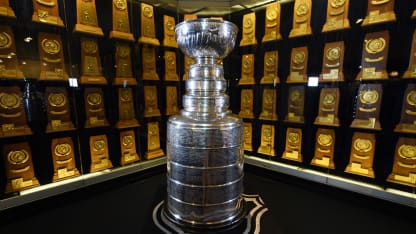Once there was a fixed cost for obtaining the Stanley Cup.
In 1892, the trophy had a reported face value of 10 guineas, which translated to about $50 at the time.
That's the price Sir Frederick Arthur Stanley, Lord Stanley of Preston and son of the 14th Earl of Derby, paid for the original bowl-shaped trophy, which he planned to present to the "the champion hockey team in the Dominion of Canada." It was to be a reminder of his time as Canada's governor general.
Stanley Cup has incredible history
Appearance, shape have changed during 125 years, but trophy's aura, mystique strong as ever

© Bernstein Associates/Getty Images
Today the Stanley Cup, which turns 125 years old on Saturday, is considered priceless; its value is not measured through traditional currency units, but rather through the sacrifices of an ever-growing yet still exclusive fraternity of players who have claimed it.
As recent commercials have romanticized, the Stanley Cup, in its various shapes and sizes, is almost mystical in its aura. It brings smiles to the most stoic of men, tears to the sternest and renders mute even the most talkative.
From its modest beginnings as a bowl measuring 7.28 inches in height and 11.42 inches in diameter to its larger-than-life status today as arguably the most famous sports trophy in the world, the Stanley Cup has always held sway over the imagination of those who have competed for it.
Its full mystique is on full display at the end of each Stanley Cup Final when an NHL dignitary -- Commissioner Gary Bettman since 1993 -- hands the trophy to the captain of the winning team.
Without fail, it is accepted eagerly and then hoisted effortlessly toward the sky despite its unwieldy combination of height (35.25 inches) and weight (34.5 pounds). Within seconds, the lucky captain is swarmed by teammates eager to touch the object of their affection.
"There's so many good things about the game of hockey, but the greatest things about our sport are our history and our tradition and, without question, the Stanley Cup is probably the greatest trophy in all of sport," said Wayne Gretzky, the captain of the Edmonton Oilers dynasty that won the Stanley Cup four times in a five-season span between 1984 and 1988. He went through the handoff ceremony each time the Oilers won.
Gretzky has spent his fair share of time with the spoils of the ultimate playoff victory and knows better than most what the trophy means to those who earn it.
"If you are lucky enough to get your name on that Stanley Cup, that is what is so unique and it is so difficult to win a Stanley Cup," Gretzky said on Sept. 27, when he was announced as the League's Centennial Ambassador. "As you see today, the parity with these 30 teams, it is really difficult. So, when you get to lift it, it's really worth it."
The trophy has always been about more than the shiny nickel and silver alloy of which it is now composed. The dreams of the young and the accomplishments of the aged in its pursuit have always defined the trophy as much as its appearance.
"It's tough to beat the allure that the Stanley Cup has," Pittsburgh Penguins defenseman Ian Cole said when he spent a day with the trophy after he and his teammates defeated the San Jose Sharks in a six-game Final last June.
"It's about dreams and them coming true and being able to share it with everybody," Penguins captain Sidney Crosby said in July when he brought the trophy to his hometown of Cole Harbour, Nova Scotia, for the second time, again sharing it with family, and friends.
Penguins coach Mike Sullivan spent his day with the Stanley Cup -- a tradition started in 1993 that affords each member of the winning team a day during the summer with the trophy to celebrate -- retracing his hockey path from neophyte to champion by stopping at his high school and his college (both in Boston) to share the trophy with those who made his journey possible.
"We wanted to share it with as many people as we can that have had an influence in our life, but also the next generation coming up," Sullivan said. "I think the Stanley Cup | Al MacInnis couldn't wait to hoist Stanley Cup]*
Since the 1926-27 season, the Stanley Cup has been the sole province of NHL teams. In 1947, the NHL entered into an agreement with the Cup's trustees that granted control of the Cup to the League and allowed it to reject challenges from other leagues and teams.
Along the way, the trophy has changed its look radically as it gradually became the hardest trophy to win in North American sports.
The simple bowl slowly morphed into a 3-foot-high trophy, in large part because of a decision in 1924 to allow for the inscription of the names of the players of the championship team each season, which led to the introduction of bands below the bowl to house those names. This was done in part to discourage players from carving their own names into the Cup, which some previous champions had done.
In 1939, the Stanley Cup was given a standardized form as a long, cigar-shaped trophy. In 1948, it was refashioned as a two-piece trophy with a wide, barrel-shaped base and a removable bowl and collar. The current iteration, a ceremonial bowl sitting atop three tiered bands, a collar and five uniform bands at the base, was introduced in 1958.
The Cup's design was improved slightly in 1963, at the behest of NHL President Clarence Campbell, who felt the original five-band Cup had become too brittle to be presented to the winning team each spring.
This is the trophy used today.
A replica of the Stanley Cup was created in 1993 and remains in the Hockey Hall of Fame, displayed when the "presentation" Cup is on the road.
The Stanley Cup remains the only professional sports trophy where the name of every member of the winning team is inscribed. As a result, bands are retired to make room for new champions while keeping the trophy at its current size.

© Bruce Bennett/Getty Images
To date, two bands have been removed with a third scheduled to be retired after the 2017 champion is crowned. The removed bands join the original bowl at the Hockey Hall of Fame.
The practice of inscribing names on the trophy has not only made the trophy bigger and more personal, it has also given the trophy much of its character. Mistakes made in the engraving process throughout the years are among the trophy's many cherished idiosyncrasies.
Goaltender Turk Broda is represented twice for the 1941-42 Toronto Maple Leafs, once as "TURK BRODA" and again as "WALTER BRODA," his given name. Goaltender Jacques Plante won the Cup five straight years with Montreal from 1956 to 1960, which is the record for consecutive championships by a team. His name was engraved differently each time. The 1971-72 champion Boston Bruins are listed as the "BQSTQN BRUINS."
The 1983-84 Edmonton Oilers list features a string of 16 X marks, used to strike the name of Basil Pocklington, the father of owner Peter Pocklington, who had no official capacity with the team. In 1996, Colorado Avalanche forward Adam Deadmarsh was the latest to have his name misspelled ("ADAM DEADMARCH"); however, the error was corrected, a Stanley Cup first.
As Gretzky said, the history and tradition of hockey, particularly the Stanley Cup, the oldest trophy in North American sports, make being an NHL champion the ultimate sporting accomplishment, a feat that affects everyone who witnesses it.
"It is an honor, it is a privilege and it is awesome to be that close to the celebration," Commissioner Bettman said, "just to see the raw emotion and passion that the players have for the game, what they have been through and their feeling of embracing the Stanley Cup. It is a sheer joy."

















